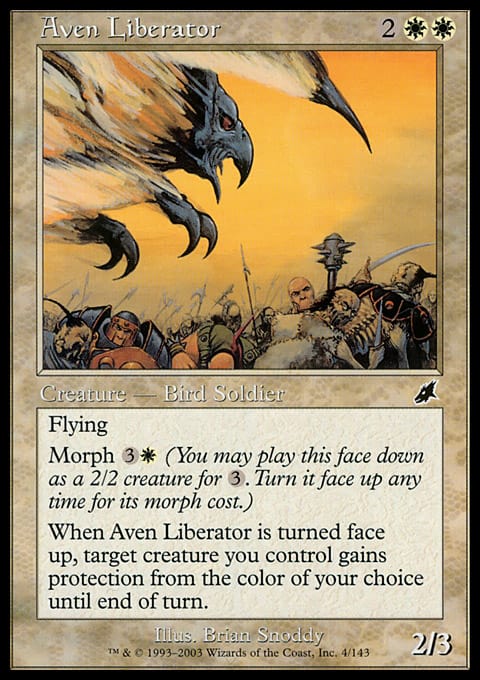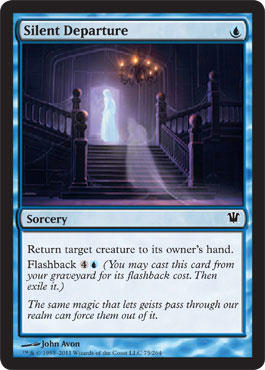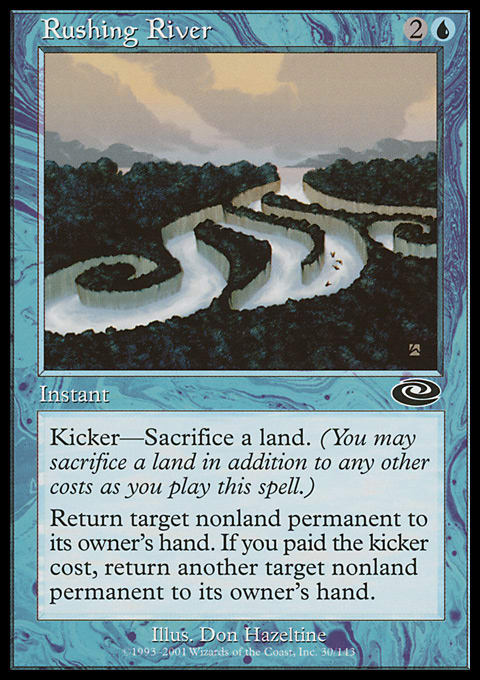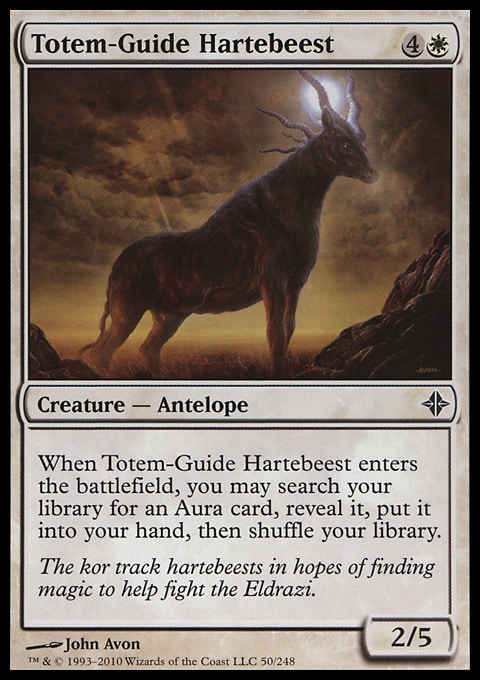Designing a Cube is a lot like Google Maps: You provide the start and end points, and the drafters then can select from among the best routes available to them. Of course, as the grand architect of this experience, it is your job in some ways to give them the best possible indicators of which way to go—you are the flashing sign warning people of the impending hurricane or the overturned bread truck. In my Cube, this role as a member of the department of transportation means I have to provide the guidance for drafting different color combinations. The question becomes how to best do this.
In Theros block, Wizards has taken the stance of using uncommon gold cards to steer drafters down certain paths. This is a useful tool, but not every Cube can adhere to this tenet. Instead, many Cubes rely on piggybacking to guide drafters. Piggybacking, as explained in the link, is the idea of using that which the audience already knows to help them make cognitive shortcuts. So, what back routes are available to those crafting Pauper Cubes? In my estimation, there are two: history and the guilds of Ravnica. Thankfully, these can overlap a bit, especially at common.
Why is this the case? Each guild is meant to shine a light on its component colors and capture an aspect of their chromatic essence. Similarly, commons have to be the most elegant execution of color philosophy (the so-called crust of the color pie). The nature of the top layer of color philosophy has remained largely consistent for the history of Magic. This leads the colors to have a cohesive identity across common. It also means that the guilded cards, at common, play into these notions. History and the guilds align because they were destined to align thanks to the color pie. In turn, this makes piggybacking off these concepts wince since they have so much Magical cultural capital.
So in this vein, let’s jump into the color pairs in alphabetical order. Today, we’re going to focus on Azorius. White and blue have historically played the skies game. These decks seek to establish early threats and then back them up with countermagic and removal (either cards like Pacifism or like Unsummon). These decks are not the best in getting into fights, but rather, they excel at avoiding them with evasive creatures (hence the skies moniker).
Azorius did not line up with this in the original Ravnica block, but the more recent visit to that urban destination gave us a W/U skies strategy for the ages. Detain was a perfect skies-style mechanic, especially when attached to a creature like Azorius Arrester. This allowed the lawmage to lay a threat and crack through for additional damage in a pastiche of card advantage. Combined with potent flyers like Lyev Skyknight and Vassal Soul, Azorius ruled the skies in Return to Ravnica.
What does recent history tell us? Looking at gold cards (again, used to guide drafting), we see W/U typified in Drogskol Captain in Innistrad/Dark Ascension and Battlewise Hoplite and Ephara's Enlightenment in Theros/Born of the Gods. If we are going to use previous notions of what W/U is to guide what Azorius should be in Cube, we should look for aggressive evasive creatures that are combined with protecting threats. Azorius should be a deck about getting into fights it knows it can win (or leap over the defenses of an opponent).
So if skies is the roadmap, what are some of the landmarks to look out for when drafting this deck?
Aven Liberator – When I think of W/U, I think of this card. My Cube used to have far more morphs than it does today. The ones that have stuck around have done so because their unmorph effects are powerful enough to warrant inclusions. Aven Liberator is an expensive version of Stave Off, but it comes with a 2/3 flyer attached. While a bit slow, this card can swing a combat phase and ensure the Azorius side comes out ahead.
Kabuto Moth – This innocuous little Spirit is an all-star. Overcosted for a small flyer, the Moth’s ability to grant a temporary Holy Strength every turn is what draws Azorius players to its light. Kabuto Moth makes any attack or block against an Azorius player a challenge—most creatures in the Cube are of similar size. The power to grant 2 toughness is the most important attribute here, as it allows a player to attack with far less fear.
Man-o'-War – The Jellyfish (and to a lesser extent its brethren Aether Adept and Mist Raven) are the perfect Azorius foot soldiers. The ability to establish a threat while removing an opponent’s blocker is just what this deck needs in the mid- to late game when dealing with medium to large threats. Azorius creatures tend to fall in the 2/2 range, which is part of what makes the Jellyfish (and the Moth) so valuable when going up against decks with larger monsters (like those lawless Gruul savages).
Silent Departure – Solid in any deck, this love child of Unsummon and Firebolt finds a sweet spot in the W/U tempo builds. The ability to sneak in damage early while clearing out a larger threat later (even for a turn) is precisely what Azor’s followers require. The 5-mana flashback cost is alluring since it is not difficult to imagine paying 5 to flash back the Departure and lay an additional 2-drop or pay the full six for a pseudo-Undo.
Blinding Beam and Rushing River – These are your game-enders. The ability to tap down or remove multiple blockers, as indicated in previous entries, is a well-worn path to victory. These cards are not expensive and have use in the early game, but it is in the later turns when they shine. While they can find home in other decks, it is in the aggressive, tempo-oriented world of Azorius where these two spells can reach their full potential.
Drafting Azorius in my Cube means drafting a base-white aggressive deck. The focus should be on mana-efficient 2-drops and other creatures that can wreak havoc on a combat step (Heavy Ballista is an additional example). Blue can lend some air support with its super-high flyers—Cloud Elemental and Scrapskin Drake—but the Islands are a support color. Blue is in the deck mostly to help keep threats off the table and to help refill a hand once it has gone dry. Mulldrifter is an all-star here, but then again, it’s great everywhere.
What does an ideal Azorius Draft deck look like? In my mind, this is what you want:
"Azorius Skies"
- Creatures (17)
- 1 Aven Liberator
- 1 Azorius Arrester
- 1 Azorius First-Wing
- 1 Benalish Cavalry
- 1 Daring Skyjek
- 1 Gideon's Lawkeeper
- 1 Infantry Veteran
- 1 Kabuto Moth
- 1 Knight of Cliffhaven
- 1 Kor Hookmaster
- 1 Kor Skyfisher
- 1 Man-o'-War
- 1 Mist Raven
- 1 Mulldrifter
- 1 Stormfront Pegasus
- 1 Syndic of Tithes
- 1 Waterfront Bouncer
- Spells (6)
- 1 Into the Roil
- 1 Rushing River
- 1 Silent Departure
- 1 Journey to Nowhere
- 1 Pacifism
- 1 Bonesplitter
- Lands (17)
- 7 Island
- 9 Plains
- 1 Azorius Chancery
It has early aggression and some late-game ways to pull ahead—if I am going the aggressive, skies route, this is the direction I want to take. This deck would not look out of place in many Draft formats from years gone by. It is familiar and makes great use of piggybacking to tap into known quantities.
Of course, there is always the opportunity to follow the advice of one Robert Frost. You know the poem, “Two roads diverged in a wood and I— I took the one that let me go deep.”
Or something like that.
White and blue share the idea of Flickering, or removing a card from play and reusing it for any enters-the-battlefield triggers. This concept is made cardboard in Momentary Blink, which is noticeably absent from the Cube. The W/U mage can still draft this deck, although it trends more toward a pure-value stack of cards. Often, this can be the result of having too few aggressive creatures in a more-beatdown oriented Azorius deck. Setting out to draft it, however, can lead to some potent stacks.
Much like the tempo version, this deck has some cards that excel in this particular strategy. While Mulldrifter shines in both, some other cards are much better-suited for the slower of the two roads.
Totem-Guide Hartebeest – This card is sneakily good. White and blue are colors with a copious amount of Aura-based removal. Not only does it have access to the all-stars of Pacifism and Faith's Fetters, it also can fetch Narcolepsy and Claustrophobia. The Murder Beest is fine with one Aura to fetch and becomes exponentially better with each additional gift from the gods. I would not hesitate to pick this card first if I were in the mood to draft this deck.
Deputy of Acquittals – The best thing about this card is that it goes late. Most cheap gold cards tend to make a lap or two around the table because they are so difficult to cast. The key here is that the Deputy, while costing 2, effectively costs far more since you want to use it to rebuy a creature that comes with a free spell. Being able to grab this little law magus late in the Draft makes each subsequent creature that much better.
Sensor Splicer – This is another expensive card that is actually two creatures in one. The Splicer shines a little brighter in this deck because of the ability to create multiple copies of the Golem.
The Azorius Flicker deck is far slower than skies, but it can dominate the late game in an avalanche of card advantage. Greater emphasis is placed on blue and on defensive creatures. A typical Flicker deck could look something like this:
"Azorius Flicker"
- Creatures (15)
- 1 Aquamoeba
- 1 Archaeomancer
- 1 Attended Knight
- 1 Augury Owl
- 1 Deputy of Acquittals
- 1 Errant Ephemeron
- 1 Hussar Patrol
- 1 Kor Skyfisher
- 1 Man-o'-War
- 1 Mulldrifter
- 1 Seacoast Drake
- 1 Sensor Splicer
- 1 Totem-Guide Hartebeest
- 1 Voidwielder
- 1 Squall Drifter
- Spells (8)
- 1 Dramatic Rescue
- 1 Exclude
- 1 Ghostly Flicker
- 1 Repulse
- 1 Arrest
- 1 Faith's Fetters
- 1 Narcolepsy
- 1 Pacifism
- Lands (17)
- 7 Plains
- 8 Island
- 1 Azorius Chancery
- 1 Azorius Guildgate
So there are two different ways to play Azorius in my Cube. Neither of these turns the color pair on its ear. Rather, tapping into the zeitgeist of the guild philosophy and the history of the colors can allow drafters to have an easier time to understand how to enter a Draft. This also makes it easy to tag cards from new sets for inclusion from new sets. If there’s a new tempo-positive creature or a strong enters-the-battlefield brawler, well, you can be sure I’m considering it for Azorius.
When you draft a Cube for the first time, do you find that if the designer uses these well-trodden paths that you have an easier time, or do you want something unexpected and new? I know where you’ll find me—carry the Grand Arbiter piggyback style.
Keep slingin’ commons—
-Alex
SpikeBoyM on Magic Online
Check out Common Cause on iTunes!
Discuss Pauper on Twitter using #mtgpauper






























